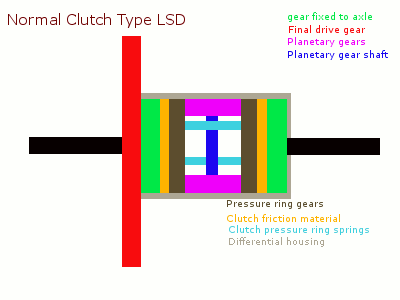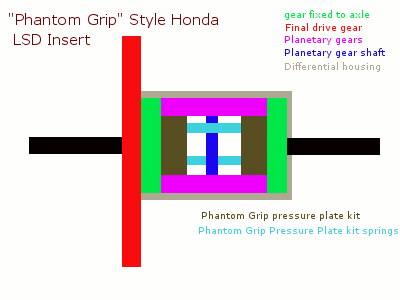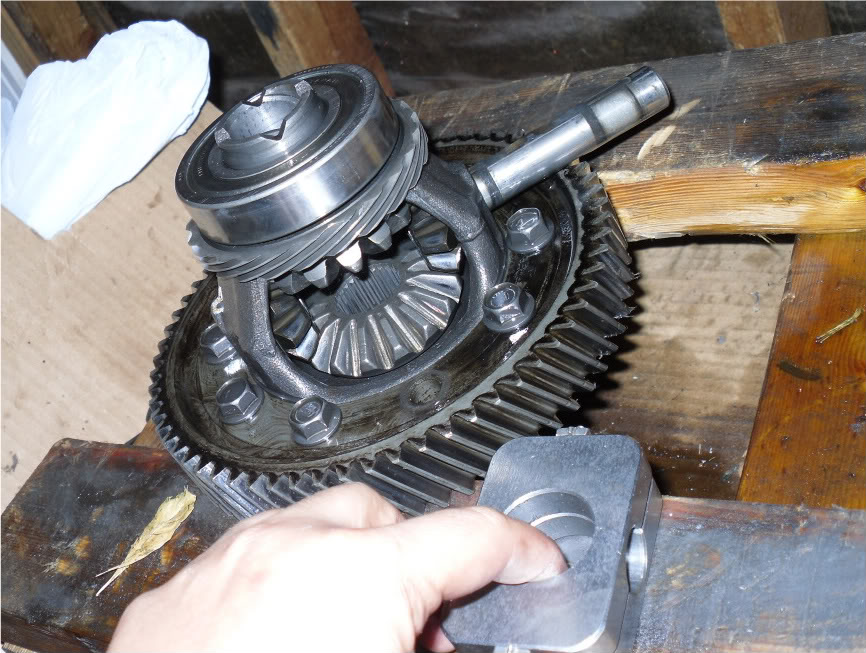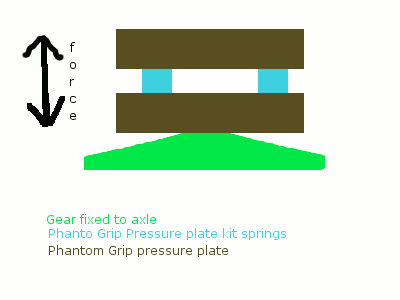How does a Phantom Grip Limited Slip insert REALLY work?
For a while now, I have been wondering how a Phantom Grip Limited Slip open differential conversion works. I have read often enough on Honda-Tech.com about how “Phantom Grip LSD’s don’t work” or “cause excessive metal shavings in the transmission oil”, and other horror stories. Never the less, lots of people are lured into buying them because “they are so much cheaper than a normal LSD”. Well, after reading this post on Honda-Tech, I decided to write this entry to study the problem and document the thought process. Hopefully you will understand the fundamentals of how a Phantom Grip Limited Slip insert works by the end of this article, and will be able to decide for yourself whether it is worth the money.
For this explanation to work, it helps to have some insight into how an LSD mystery box works. In this case, we will discuss a clutch-type LSD since this is the style of LSD the Phantom Grip purports to be closest to. But first, a picture for reference:

A Clutch-Type Limited slip differential works by using a high friction clamping surface(orange in color), sometimes many plates with high friction surfaces, to resist independent motion of the gears fixed to the axles(in green), and thus causes the front wheels to spin at the same speed. This independent motion can be caused by driving through a corner, where the outside wheel spins faster than the inside wheel, or often also by torque steer. If you go into a hard left corner, the left side axle (in black, attached to the green) will be spinning slow with not very much load on it, and the right side will be spinning faster with lots of load on it. This causes the clutch friction material on the left side to break free and rotate the pressure ring gear on the left side at the same rate as the pressure ring gear on the right side, but since the gear fixed to the axle on the left side is not attached directly to the pressure ring gear on the left, it simply overcomes the friction material’s resistance, and is allowed to spin.
Torque steer is particularly common in front wheel drive cars, where one drive axle is longer than the other, causing different amounts of torque to be applied to each wheel. This high friction surface still allows the wheels to turn independently of each other, but is not nearly as willing to allow this because the high clamping force imparted on the friction surface by the internal springs (baby blue color) of the differential. This willingness to spin both sides at different rates in the clutch type differential is significantly less than the willingness to allow both sides to spin at a different rate that an open differential normally allows. The consequence is that if you do a burnout in a open differential car, and turn the wheel slightly, you may end up with one wheel of fury, while the other wheel is just hanging out. The clutch type differential can help greatly in using the traction of both tires during a burnout, even at a higher than 0 degree steering angle, and it is all thanks to the calibration of the clutch friction material and the pressure exerted on the pressure ring gears by the clutch pressure ring springs.
Careful engineering is performed to find a good balance between friction surface area and spring strength, so the differential is not locked all the time, but not so weak that it acts as an open differential.
Next, a diagram of a stock Honda FWD differential with the “Phantom Grip Limited Slip” insert:

As you can see from the diagrams, right off the bat, calling a Phantom Grip insert a clutch type differential is not entirely true, because there is no clutch friction material(orange in color, diagram 1) as there is in a normal clutch type differential. In fact, there are several parts that appear absent in comparing diagrams 1 and 2.
You may also note that the clutch type LSD has pressure ring gears (brown in color, diagram 1) driven by the planetary gear system(purple in color, diagrams 1 and 2), where as the Phantom Grip planetary gears are simply the planetary gears provided by the OEM manufacturer of the open diff.
This brings the next question: If the Phantom Grip has no clutch friction material, and the pressure ring component is a gear already being driven directly by the planetary gear system, then how does it work?
It appears that the Phantom Grip Limited Slip insert is only capable of providing friction on the gears driving the axles, which attempts to keep the wheels moving at the same speed. It is important to note that the springs (baby blue in color) in both diagrams are providing some large force in the direction of the gears connected to the axles. In a normal clutch type differential, this force increases the clamping force of the clutch plates much in the same way as a higher clamping load clutch helps a high horsepower car’s clutch not slip when the clutch is dumped. The Phantom Grip Limited Slip insert is imparting force via a spring in the same manner, but that clamping force is being exerted on the gear hub and the face of the axle gears! There is no friction material, and no set of flat side gears for a friction surface at all. In fact the total friction surface area provided by the stock open diff, all together, is probably less than 1 inch square. Unless the springs in the device provide tens of thousands of psi of force, it is unlikely that this device would do anything at all. This is astonishing! A quick look at an installed Phantom Grip Limited Slip insert shows how small the axle gear to limited slip insert contact surface must be.

Diagram 3 above makes a big case for what shows up below. You notice that in the gears that are attached to the axle, the gears are sloped downward, while the Phantom Grip plate is flat. You will also note that the contact patch is a steel gear to aluminum or steel Phantom Grip plate contact, which when covered in transmission oil, can’t possible impart that much friction on the axle gears, even with monster springs.
In the following picture, Diagram 4, you can see that the theoretical surface area of contact for the Phantom Grip limited slip insert on the tapered gear that is fixed to the axle in green is miniscule. The drawing below is not to scale in any sort of way, so the angle of contact may be more or less shallow, but it illustrates just how much different the Phantom Grip Limited Slip insert is from a real Clutch Type limited slip.

It may now be obvious how metal shavings will most likely wind up in your oil using the Phantom Grip. The friction plate of the device itself is resting on gears that don’t necessarily spin incredibly fast or for long periods of time, but they do spin, and over time, it is easy to see how the friction plate of the Phantom Grip may be worn down due to the tiny contact patch and heavy load on that patch. Real clutch type LSD’s have wearing issues of their own, but are engineered from the beginning for the purpose of acting as a clutch.
So with that, we come to the end of this post. A few unknowns are left for me to ponder, such as the actual, real contact area the Phantom grip has in a normal Honda open diff, and also what exactly the spring pressure is in the limited slip insert. These factors can make a difference in how well the device works, but in my opinion, this short explanation is enough for me to determine that I will absolutely spend the extra $400 or $500 for a real clutch type or helical LSD over the Phantom Grip Limited Slip insert.